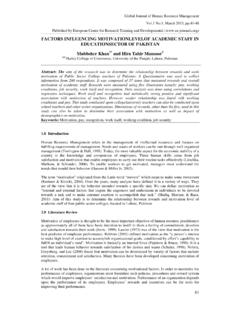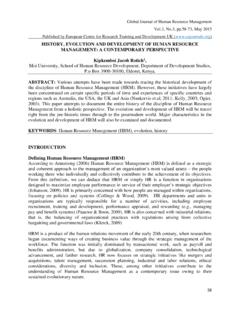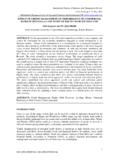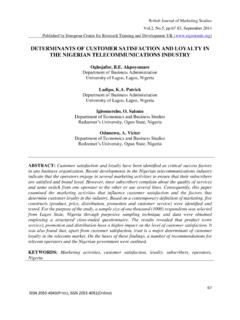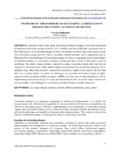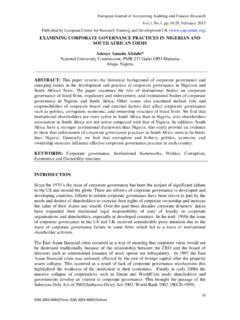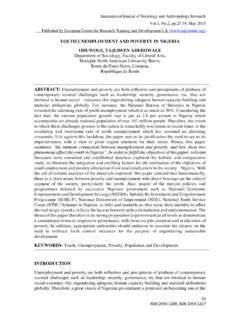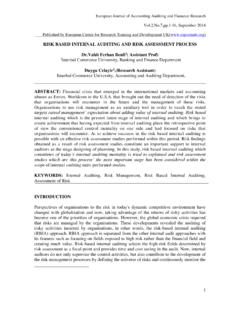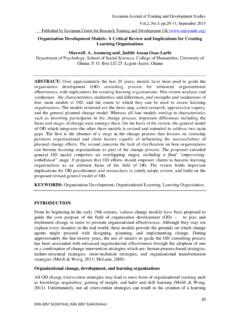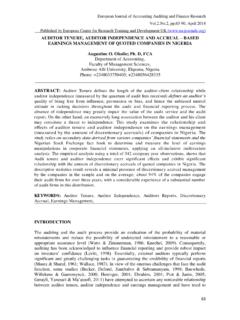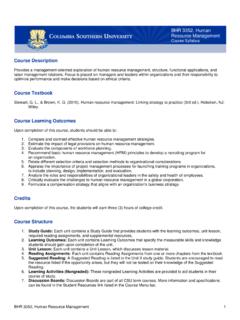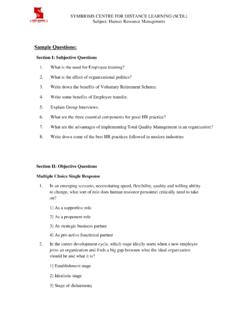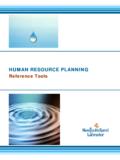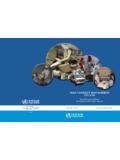Transcription of Global Journal of Human Resource Management …
1 Global Journal of Human Resource Management No. 2, pp. 1-12, March 2015 Published by European Centre for Research Training and Development UK ( ) 1 ISSN 2053-5686(Print), ISSN 2053-5694(Online) Human Resource Management AND PUBLIC ORGANIZATIONS Dr Naima YAHIAOUI1, Ahlem ANSER2 , Dr Samia LAHOUEL3 Faculty of Economic, commercial and Management sciences, Batna University, Batna, Algeria ABSTRACT: This research provide the most important foundations of Human Resource Management that we can apply in both public and private sector organizations such as job design, control, teamwork, leadership, managerial roles, staffing practices and career then moves on to review the process of HRM in private and public organizations, performance, functions in the PS, in addition to the operations of Human Resource Management in public sector.
2 The main standards and its application, then we talk about the HR role in the public sector reform which is giving greater involvement in public sector in order to improve services. KEYWORDS: Human Resource , Management , public organizations, process of HRM, performance. INTRODUCTION Efficiency of administration is directly depending on Human resources, therefore we need to develop our public institutions through modernizing and improving Human Resource Management by building up efficiency of individuals and improving theire performance.
3 Therefore Algeria draws intrest to this important Resource through the rehabilitation of administration and making it citizenship and activating the transparency, responsibility, accelerate the response to the concerns of citizens, and provide services with best quality and lowest cost Problematique: How can we exploit Human Resource in public sector? From this main question we ask the following sub-questions: What is Human Resource Management ? What are the operations of Human Resource Management in the public sector?
4 Importance of the research: Importance of this research is knowing the operations that we need to incorporate in Human Resource Management for public sector development. Research goals: This research aimed to Highlighting the need to develop Human Resource Management . Identifying Human Resource Management operations in the public sector. Showing the standards of Human Resource Management in public sector. Structure of the resourch: The Resource includes three main axes: 1_ Human Resource Management . Global Journal of Human Resource Management No.
5 2, pp. 1-12, March 2015 Published by European Centre for Research Training and Development UK ( ) 2 ISSN 2053-5686(Print), ISSN 2053-5694(Online) 2_ Human Resource Management in public and private organizations. 3_ operations of Human Resource Management in public sector. 1_ Human Resource Management : The roots of HRM go back as far as the 1950s, when writers like Drucker and McGregor stressed the need for visionary goal-directed leadership and Management of business integration .This was succeeded by the behavioural science movement in the 1960s, headed by Maslow, Argyris and Herzberg.
6 These scholars emphasised the value aspect of Human resources (HR) in organisations and argued for a better quality of working life for workers. This formed the basis of the organisational development movement initiated by Bennis in the The Human Resource accounting (HRA) theory developed by Flamholtz (1974) was an outcome of these sequential developments in the field of HRM and is considered to be the origin of HRM as a defined school of thought. HRA emphasised Human resources as assets for any organisation.
7 This asset view began to gain support in the 1980s. The last twenty-five years or so have then witnessed rapid developments in the field of HRM, which are an outcome of a number of factors such as growing competition (mainly to US/UK firms by Japanese firms), slow economic growth in the Western developed nations, realisation about the prospects of HRM s contribution towards firms performance, creation of HRM chairs in universities and HRM-specific positions in the industry, introduction of HRM into curricula in the early 1980s, and a continuous emphasis on the involvement of HRM strategy in the business The definition of Human Resource Management .
8 All planned and controlled activities of an organization to build and maintain the relation between employees and the organization in order to meet both buseness objectives and employees Other definitions: HRM is a process for staffing the organization and sustaining high employee performance. HRM can be defined as all the practices , systems and procedures implemented to attract, acquire, develop and manage Human resources to achieve the goals of an organization. Simply it is managing the employment Foundations of Human Resource Management : We will briefly review the most important foundation in HRM:5 1 _ job design and control: Traditional forms of work organization are based on the division of work.
9 As such, they require jobs to be analysed and designed along strict lines of demarcation and then grouped into separate functional units. With time jobes can be enlarged so that specialist can be more responsible for an increased number of tasks to avoid rigid job demarcation. Control operates in the traditional work organization through direct observation , limited feedback, personel supervision, collection of progress reports, and formal performance 1, 2 : 3 : 4 : 5 :Carlos Senchez_Rund, Richard Whatington, Javier quintalla, HRM implications of new forms of organizing, Spain, 2000,p : 04.
10 Global Journal of Human Resource Management No. 2, pp. 1-12, March 2015 Published by European Centre for Research Training and Development UK ( ) 3 ISSN 2053-5686(Print), ISSN 2053-5694(Online) evaluation, the new way of control is put employees in charge by exercising broad judgment and employee self-discipline. 2_ Team work, leadership, and the managerial roles: 2_1. Teamwork: Work in team, while scarce in the traditional approach to work organization and dominates the new organizational arrangements. Team memberse manage there own resources( planning, scheduling, co-ordination with other ).
